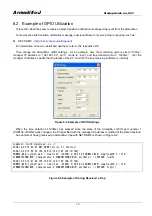
Armadillo-J
Startup Guide ver.2.03
Table 6-1 GPIO Port Mapping
Port Number
CON2 (GPIO)
1 PORTA0
2 PORTA1
3 PORTA2
4 PORTA5
5 PORTA6
Mode:
This field is used to specify the function to be assigned to each GPIO port. If a port is not to be used as
GPIO, set it to “serial”, if it is to be used as an input port, set it to “input”, and if it is to be used as an output
port, set it to “output”.
This GPIO mode setting is retained even when the Armadillo-J is restarted. The default value is “serial”.
Status:
This field is used to monitor or set the current value of each GPIO port. However, if GPIO mode is set
to ”serial” or “input”, changing a setting value will have no effect.
Note that GPIO status setting is not retained when the Armadillo-J is restarted.
Initial:
This field is used to specify the initial state of each GPIO port when the Armadillo-J is started. However, if
GPIO mode at startup is not set to “output”, the setting value will have no effect. It also should be noted
that the current GPIO state is not changed.
The initial state of GPIO is retained even when the Armadillo-J is restarted. The default setting is “LOW”.
Trap Time:
This field is used to specify the length of time (ms) that elapses after the state of the GPIO port set to
“input” changes before a notification message is generated. The valid values are 30ms to 604800000ms.
If a notification is not required, set it to “0”.
This trap time is retained even when the Armadillo-J is restarted. The default value is “0”.
Note: Since SNMP is used, the GPIO settings can be configured remotely from a MIB browser etc. For
details on MIB used by the Armadillo-J, refer to the “mibs/armadillo-j.mib” file contained in the
supplied CD.
14








































